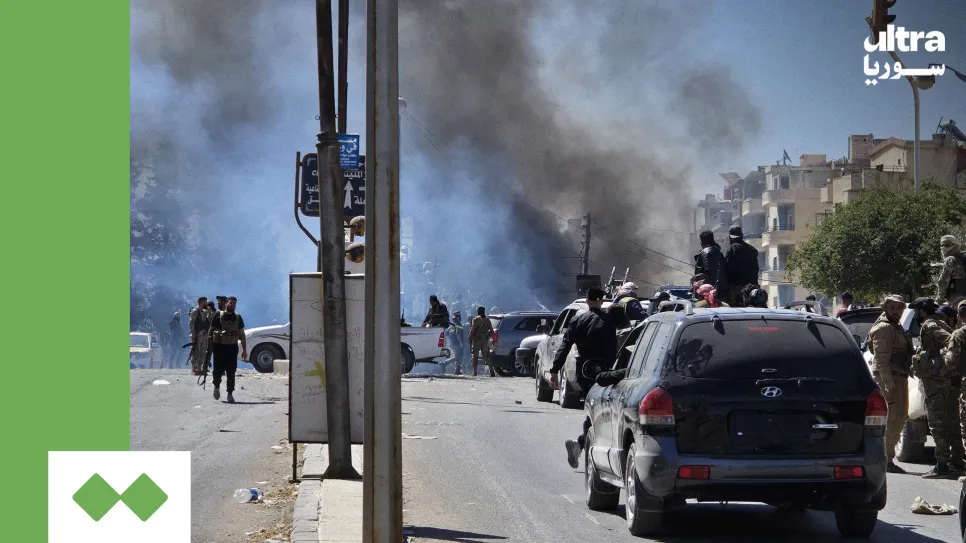In a dramatic escalation of the conflict gripping southern Syria, Israeli fighter jets launched multiple coordinated airstrikes on military convoys belonging to the Syrian government in and around the city of Suweida. The attacks, reportedly carried out with the knowledge and coordination of the United States, targeted heavy military equipment including tanks, armoured personnel carriers, and rocket artillery, as well as key access routes used by withdrawing Syrian forces.
The Israeli military said the airstrikes were “politically directed” and aimed at disrupting the Syrian army’s operations in the predominantly Druze province, citing the movement of armoured convoys toward Suweida as a violation of long-standing demilitarization agreements near Israel’s northern borders.
A senior Israeli official, speaking to Channel 14, confirmed the operations were conducted “in coordination with the American side,” though further details on the nature and extent of this cooperation were not provided.
“Brotherhood Alliance” and the Druze Factor
Israeli Prime Minister Benjamin Netanyahu and Defense Minister Yoav Gallant issued a joint statement confirming that they had instructed the military to immediately strike any Syrian forces entering Suweida, framing the intervention as part of Israel’s duty to protect the Druze community in Syria, in line with what they called a “brotherhood alliance” with Druze citizens in Israel.
“We are committed to preventing harm to the Druze in Syria,” Netanyahu declared, adding that the Syrian regime’s actions endangered both the demilitarization policy and the safety of civilians in the border-adjacent region.
Renewed Violence and Civilian Suffering
The airstrikes coincided with a fresh wave of violence in Suweida and neighbouring Daraa province. Israeli warplanes struck a police headquarters in central Suweida and carried out attacks on the 12th Brigade base in Izraa, Daraa. These strikes came just as Syrian government forces began withdrawing and the Ministry of Interior deployed internal security units to restore order.
Despite the declaration of a ceasefire earlier in the day by Syrian Defence Minister Marhaf Abu Qusra, the city plunged into chaos. Local sources described scenes of horror: dozens of civilians killed or wounded, homes looted and set on fire, and mass displacement from multiple neighbourhoods.
One particularly harrowing incident involved a massacre at the al-Radwan family guesthouse, where at least nine civilians were reportedly executed. Eyewitness accounts described violent home raids, summary killings, and blocked ambulance routes preventing medical access to the wounded.
How the Crisis Erupted
The violence in Suweida has escalated over the past 48 hours following a seemingly isolated robbery of a local merchant. That incident quickly spiraled into retaliatory kidnappings between Druze residents and tribal groups, then exploded into armed clashes, drone strikes, and the use of heavy weaponry in civilian areas.
On July 13, clashes erupted in the al-Maqous neighbourhood of Suweida, with reports of crossfire, mortar attacks, and mounting civilian casualties, including children. Villages such as al-Soura and al-Tayra saw tribal militias using drones and attacking police checkpoints and homes. Families began fleeing en masse, and secondary school exams were officially postponed.
The Druze group Men of Dignity declared a state of emergency, accusing the government of abandoning its duty to protect civilians and calling for restraint and dialogue. Initial mediation efforts bore fruit, with the release of some hostages and tribal leaders agreeing to de-escalation. However, by early July 15, violence resumed with greater intensity.
“Foreign-Imposed Agreement” and Fractured Authority
Minister Abu Qusra had ordered the army to cease all offensive operations and prepare to transfer control of the city to internal security forces. The government claimed it had coordinated this with Druze spiritual leaders, but local figures quickly rejected that narrative.
The Druze spiritual leader Sheikh Hikmat al-Hijri publicly denounced the so-called agreement, saying it was “imposed from abroad” and lacked communal consensus. Lebanese Druze leader Walid Jumblatt also warned of Israeli manipulation, urging the people of Suweida not to fall into what he called “an Israeli trap,” and insisting that the political solution must be brokered by the Syrian state, not foreign powers.
A Region on the Brink
The situation in Suweida has left residents and observers alike questioning the legitimacy and effectiveness of the ceasefire. With civilians caught in the crossfire, widespread reports of human rights abuses, and conflicting narratives from Damascus, Tel Aviv, and local actors, the province teeters on the edge of collapse.
Journalist Rayan Maarouf of Suweida 24 expressed the despair of many: “Our city is violated. We are being killed in our homes and on our streets. We welcomed tens of thousands of war refugees, and now our own homes are being looted and burned.”
His emotional testimony concluded: “Maybe these are our last words. But I believe tyranny cannot last forever. God will judge the oppressor.”
As of now, no clear party has claimed responsibility for the massacres and looting. The Syrian government blames “outlaw elements,” while locals accuse the military itself. Meanwhile, the Israeli government maintains that its strikes are defensive and aimed at preventing regime attacks on Druze civilians. But on the ground in Suweida, the lines between protector, aggressor, and bystander are blurring fast.
The coming days will determine whether this volatile region descends further into violence—or whether the fragile calls for peace and accountability will finally be heeded.


